Left Ventricular Remodeling and Heart Failure Predictors in Acute Myocardial Infarction Patients with Preserved Left Ventricular Ejection Fraction after Successful Percutaneous Intervention in Western Romania
Abstract
:Simple Summary
Abstract
1. Introduction
2. Materials and Methods
2.1. Patient Selection
2.2. Data Extraction
2.3. Definition of Covariates
2.4. Serum Biomarkers
2.5. PCI
2.6. Echocardiography
2.6.1. Conventional Echocardiography
2.6.2. Two Dimensional-Speckle Tracking Echocardiography (2D-STE)
2.7. Statistical Analysis
3. Results
4. Discussion
5. Conclusions
Author Contributions
Funding
Institutional Review Board Statement
Informed Consent Statement
Data Availability Statement
Conflicts of Interest
References
- Opie, L.H.; Commerford, P.J.; Gersh, B.J.; Pfeffer, M.A. Controversies in ventricular remodeling. Lancet 2006, 367, 356–367. [Google Scholar] [CrossRef]
- Konstam, M.A.; Kramer, D.G.; Patel, A.R.; Maron, M.S.; Udelson, J.E. Left ventricular remodeling in heart failure: Current concepts in clinical significance and assessment. JACC Cardiovasc. Imaging 2011, 4, 98–108. [Google Scholar] [CrossRef] [PubMed] [Green Version]
- Bolognese, L.; Neskovic, A.N.; Parodi, G.; Cerisano, G.; Buonamici, P.; Santoro, G.M.; Antoniucci, D. Left ventricular remodeling after primary coronary angioplasty: Patterns of left ventricular dilation and long-term prognostic implications. Circulation 2002, 106, 2351–2357. [Google Scholar] [CrossRef] [PubMed] [Green Version]
- Møller, J.E.; Hillis, G.S.; Oh, J.K.; Reeder, G.S.; Gersh, B.J.; Pellikka, P.A. Wall motion score index and ejection fraction for risk stratification after acute myocardial infarction. Am. Heart J. 2006, 151, 419–425. [Google Scholar] [CrossRef]
- Suzuki, S.; Yoshimura, M.; Nakayama, M.; Mizuno, Y.; Harada, E.; Ito, T.; Nakamura, S.; Abe, K.; Yamamuro, M.; Sakamoto, T.; et al. Plasma level of B-type natriuretic peptide as a prognostic marker after acute myocardial infarction: A long-term follow-up analysis. Circulation 2004, 14, 1387–1391. [Google Scholar] [CrossRef] [Green Version]
- Liu, Y.W.; Tsai, W.C.; Su, C.T.; Lin, C.C.; Chen, J.H. Evidence of left ventricular systolic dysfunction detected by automated function imaging in patients with heart failure and preserved left ventricular ejection fraction. J. Card. Fail. 2009, 15, 782–789. [Google Scholar] [CrossRef]
- Fox, K.A.; Dabbous, O.H.; Goldberg, R.J.; Pieper, K.S.; Eagle, K.A.; Van de Werf, F.; Avezum, A.; Goodman, S.G.; Flather, M.D.; Anderson, F.A., Jr.; et al. Prediction of risk of death and myocardial infarction in the six months after presentation with acute coronary syndrome: Prospective multinational observational study (GRACE). BMJ 2006, 333, 1091. [Google Scholar] [CrossRef] [Green Version]
- Tsai, W.C.; Liu, Y.W.; Huang, Y.Y.; Lin, C.C.; Lee, C.H.; Tsai, L.M. Diagnostic value of segmental longitudinal strain by automated function imaging in coronary artery disease without left ventricular dysfunction. J. Am. Soc. Echocardiogr. 2010, 23, 1183–1189. [Google Scholar] [CrossRef]
- Ibanez, B.; James, S.; Agewall, S.; Antunes, M.J.; Bucciarelli-Ducci, C.; Bueno, H.; Caforio, A.L.P.; Crea, F.; Goudevenos, J.A.; Halvorsen, S.; et al. ESC Scientific Document Group 2017 ESC Guidelines for the management of acute myocardial infarction in patients presenting with ST-segment elevation: The Task Force for the management of acute myocardial infarction in patients presenting with ST-segment elevation of the European Society of Cardiology (ESC). Eur. Heart J. 2018, 39, 119–177. [Google Scholar] [CrossRef] [Green Version]
- Roffi, M.; Patrono, C.; Collet, J.P.; Mueller, C.; Valgimigli, M.; Andreotti, F.; Bax, J.J.; Borger, M.A.; Brotons, C.; Chew, D.P.; et al. ESC Scientific Document Group 2015 ESC Guidelines for the management of acute coronary syndromes in patients presenting without persistent ST-segment elevation: Task Force for the Management of Acute Coronary Syndromes in Patients Presenting without Persistent ST-Segment Elevation of the European Society of Cardiology (ESC). Eur. Heart J. 2016, 37, 267–315. [Google Scholar] [CrossRef]
- Kourosh, S.; Diana, S.; Hassan, J. Prediction of survival after myocardial infarction using Killip class. Int. J. Clin. Med. 2012, 3, 563–568. [Google Scholar] [CrossRef]
- Levey, A.S.; Stevens, L.A.; Schmid, C.H.; Zhang, Y.L.; Castro, A.F., 3rd; Feldman, H.I.; Kusek, J.W.; Eggers, P.; Van Lente, F.; Greene, T.; et al. CKD-EPI (Chronic Kidney Disease Epidemiology Collaboration). A new equation to estimate glomerular filtration rate. Ann. Intern. Med. 2009, 150, 604–612. [Google Scholar] [CrossRef] [PubMed]
- Lang, R.M.; Bierig, M.; Devereux, R.B.; Flachskampf, F.A.; Foster, E.; Pellikka, P.A.; Picard, M.H.; Roman, M.J.; Seward, J.; Shanewise, J.S.; et al. Chamber Quantification Writing Group; American Society of Echocardiography’s Guidelines and Standards Committee; European Association of Echocardiography. Recommendations for chamber quantification: A report from the American Society of Echocardiography’s Guidelines and Standards Committee and the Chamber Quantification Writing Group, developed in conjunction with the European Association of Echocardiography, a branch of the European Society of Cardiology. J. Am. Soc. Echocardiogr. 2005, 18, 1440–14463. [Google Scholar] [CrossRef] [PubMed]
- Quiñones, M.A.; Otto, C.M.; Stoddard, M.; Waggoner, A.; Zoghbi, W.A. Doppler Quantification Task Force of the Nomenclature and Standards Committee of the American Society of Echocardiography. Recommendations for quantification of Doppler echocardiography: A report from the Doppler Quantification Task Force of the Nomenclature and Standards Committee of the American Society of Echocardiography. J. Am. Soc. Echocardiogr. 2002, 15, 167–184. [Google Scholar] [CrossRef] [Green Version]
- Ingul, C.B.; Malm, S.; Refsdal, E.; Hegbom, K.; Amundsen, B.H.; Støylen, A. Recovery of function after acute myocardial infarction evaluated by tissue Doppler strain and strain rate. J. Am. Soc. Echocardiogr. 2010, 23, 432–438. [Google Scholar] [CrossRef]
- Temporelli, P.L.; Giannuzzi, P.; Nicolosi, G.L.; Latini, R.; Franzosi, M.G.; Gentile, F.; Tavazzi, L.; Maggioni, A.P. GISSI-3 Echo Substudy Investigators. Doppler-derived mitral deceleration time as a strong prognostic marker of left ventricular remodeling and survival after acute myocardial infarction: Results of the GISSI-3 echo substudy. J. Am. Coll. Cardiol. 2004, 43, 1646–1653. [Google Scholar] [CrossRef] [Green Version]
- van der Bijl, P.; Abou, R.; Goedemans, L.; Gersh, B.J.; Holmes, D.R., Jr.; Marsan, N.A.; Delgado, V.; Bax, J.J. Left Ventricular Post-Infarct Remodeling: Implications for Systolic Function Improvement and Outcomes in the Modern Era. JACC Heart Fail. 2020, 8, 131–140. [Google Scholar] [CrossRef]
- Lombardo, A.; Niccoli, G.; Natale, L.; Bernardini, A.; Cosentino, N.; Bonomo, L.; Crea, F. Impact of microvascular obstruction and infarct size on left ventricular remodeling in reperfused myocardial infarction: A contrast-enhanced cardiac magnetic resonance imaging study. Int. J. Cardiovasc. Imaging 2012, 28, 835–842. [Google Scholar] [CrossRef]
- Bogaert, J.; Bosmans, H.; Maes, A.; Suetens, P.; Marchal, G.; Rademakers, F.E. Remote myocardial dysfunction after acute anterior myocardial infarction: Impact of left ventricular shape on regional function: A magnetic resonance myocardial tagging study. J. Am. Coll. Cardiol. 2000, 35, 1525–1534. [Google Scholar] [CrossRef] [Green Version]
- Rademakers, F.; Van de Werf, F.; Mortelmans, L.; Marchal, G.; Bogaert, J. Evolution of regional performance after an acute anterior myocardial infarction in humans using magnetic resonance tagging. J. Physiol. 2003, 546, 777–787. [Google Scholar] [CrossRef]
- Hassell, M.E.; Vlastra, W.; Robbers, L.; Hirsch, A.; Nijveldt, R.; Tijssen, J.G.; van Rossum, C.; Zijlstra, F.; Piek, J.J.; Delewi., R. Long-term left ventricular remodelling after revascularisation for ST-segment elevation myocardial infarction as assessed by cardiac magnetic resonance imaging. Open Heart 2017, 4, e000569. [Google Scholar] [CrossRef] [PubMed]
- Bordejevic, D.A.; Pârvănescu, T.; Petrescu, L.; Mornoș, C.; Olariu, I.; Crișan, S.; Văcărescu, C.; Lazăr, M.; Morariu, V.; Citu, I.M.; et al. Left Ventricular Remodeling Risk Predicted by Two-Dimensional Speckle Tracking Echocardiography in Acute Myocardial Infarction Patients with Midrange or Preserved Ejection Fraction in Western Romania. Clin. Risk Manag. 2021, 17, 249–258. [Google Scholar] [CrossRef] [PubMed]
- Motoki, H.; Borowski, A.G.; Shrestha, K.; Troughton, R.W.; Tang, W.H.; Thomas, J.D.; Klein, A.L. Incremental prognostic value of assessing left ventricular myocardial mechanics in patients with chronic systolic heart failure. J. Am. Coll. Cardiol. 2012, 60, 2074–2081. [Google Scholar] [CrossRef] [PubMed]
- Ebeid, H.; El Hady, R.A.; El Khashab, K.; Husein, M. Left ventricular global longitudinal strain in acute myocardial infarction and incidence of in hospital heart failure. EurEcho 2019, 60, B4697.30. EurEcho 2019, 60, B4697.30. [Google Scholar]
- Ersbøll, M.K. Left ventricular global longitudinal strain in acute myocardial infarction--with special reference to neurohormonal activation, in-hospital heart failure and prognosis. Dan Med. J. 2013, 60, B4697. [Google Scholar]
- Luvsansuren, B.; Chimed, S. Significance of left ventricular global longitudinal strain assessment in patients with preserved ejection fraction after acute myocardial infarction. Eur. Heart J. 2020, 41 (Suppl. 2), 1212. [Google Scholar] [CrossRef]
- Rodriguez-Palomares, J.F.; Gavara, J.; Ferreira-González, I.; Valente, F.; Rios, C.; Rodríguez-García, J.; Bonanad, C.; García Del Blanco, B.; Miñana, G.; Mutuberria, M.; et al. Prognostic Value of Initial Left Ventricular Remodeling in Patients With Reperfused STEMI. JACC Cardiovasc. Imaging 2019, 12, 2445–2456. [Google Scholar] [CrossRef]
- McMurray, J.J.; Packer, M.; Desai, A.S.; Gong, J.; Lefkowitz, M.P.; Rizkala, A.R.; Rouleau, J.L.; Shi, V.C.; Solomon, S.D.; Swedberg, K.; et al. PARADIGM-HF Investigators and Committees. Angiotensin-neprilysin inhibition versus enalapril in heart failure. N. Engl J. Med. 2014, 371, 993–1004. [Google Scholar] [CrossRef] [Green Version]
- Torrado, J.; Cain, C.; Mauro, A.G.; Romeo, F.; Ockaili, R.; Chau, V.Q.; Nestler, J.A.; Devarakonda, T.; Ghosh, S.; Das, A.; et al. Sacubitril/Valsartan Averts Adverse Post-Infarction Ventricular Remodeling and Preserves Systolic Function in Rabbits. J. Am. Coll. Cardiol. 2018, 72, 2342–2356. [Google Scholar] [CrossRef]
- Pfeffer, M.A.; Claggett, B.; Lewis, E.F.; Granger, C.B.; Køber, L.; Maggioni, A.P.; Mann, D.L.; McMurray, J.J.V.; Rouleau, J.-L.; Solomon, S.D.; et al. For the PARADISE-MI Investigators and Committees. Angiotensin Receptor–Neprilysin Inhibition in Acute Myocardial Infarction. N. Engl. J. Med. 2021, 385, 1845–1855. [Google Scholar] [CrossRef]
- Frantz, S.; Hundertmark, M.J.; Schulz-Menger, J.; Bengel, F.M.; Bauersachs, J. Left ventricular remodelling post-myocardial infarction: Pathophysiology, imaging, and novel therapies. Eur. Heart J. 2022, 43, 2549–2561. [Google Scholar] [CrossRef] [PubMed]
- Anker, S.D.; Butler, J.; Filippatos, G.; Ferreira, J.P.; Bocchi, E.; Böhm, M.; Brunner–La Rocca, H.P.; Choi, D.J.; Chopra, V.; Chuquiure-Valenzuela, E.; et al. Empagliflozin in heart failure with a preserved ejection fraction. N. Engl. J. Med. 2021, 385, 1451–1461. [Google Scholar] [CrossRef] [PubMed]
- McMurray, J.J.V.; Solomon, S.D.; Inzucchi, S.E.; Kober, L.; Kosiborod, M.N.; Martinez, F.A.; Ponikowski, P.; Sabatine, M.S.; Anand, I.S.; Bělohlávek, J.; et al. Dapagliflozin in patients with heart failure and reduced ejection fraction. N. Engl J. Med. 2019, 381, 1995–2008. [Google Scholar] [CrossRef] [PubMed] [Green Version]
- Wu, L.; Luan, Y.; Li, Y.; Wang, M.; He, J.; Jin, C.; Zhang, W. Effects of trimetazidine on ventricular remodeling in coronary artery disease patients with left ventricular hypertrophy: The rationale and design of a randomized controlled trial. BMC Cardiovasc. Disord. 2020, 20, 1–7. [Google Scholar] [CrossRef]




| AMI Patients with LVEF ≥50% after PCI | Group I (LVEF ≥50%) (n = 186) | Group II LVEF Decrease (<50%) (n = 58) | Overall (n = 244) | p Value |
|---|---|---|---|---|
| At baseline | ||||
| STEMI/NSTEMI (n, %) | 165 (89)/21 (11) | 55 (94)/5 (6) | 220 (96)/24 (17) | 0.27 |
| Age (years) | 64.8 ± 12 | 72.0 ± 13 | 66 ± 13 | <0.0001 |
| Male sex (n, %) | 130 (70) | 48 (82) | 178 (73) | 0.06 |
| Diabetes mellitus | 104 (56) | 34 (58) | 138 (56) | 0.78 |
| Systemic hypertension | 117 (63) | 54 (94) | 171 (70) | <0.0001 |
| Hypercholesterolemia | 138 (74) | 50 (86) | 188 (77) | 0.05 |
| Smoking history | 65 (35) | 30 (50) | 95 (39) | 0.04 |
| Obesity | 52 (28) | 12 (20) | 64 (28) | 0.22 |
| SBP (mmHg) | 128.0 ± 12.1 | 145.6 ± 13.8 | 129.8 ± 27.0 | <0.0001 |
| DBP (mmHg) | 79.3 ± 6.5 | 86.7 ± 13.2 | 75.9 ± 15.9 | <0.0001 |
| Heart rate (beats/min) | 82 ± 17 | 79 ± 21 | 80 ± 19 | 0.20 |
| Chronic renal failure | 50 (27) | 24 (29) | 74 (30) | 0.76 |
| Killip class | ||||
| 52 (28) | 1 (2) | 53 (22) | <0.0001 |
| 106 (57) | 10 (18) | 116 (47) | <0.0001 |
| 17 (9) | 28 (49) | 45 (20) | <0.0001 |
| 11 (6) | 18 (31) | 29 (12) | <0.0001 |
| Peak CPK-MB (IU/L), median (25th, 75th percentile) | 172 (67.2, 332.5) | 258 (81, 498.25) | 187 (77, 393) | <0.01 |
|
NT-proBNP (ng/L) median (25th, 75th percentile) | 220 (60, 307) | 900 (210, 2450) | 220 (80, 500) | 0.64 |
| eGFR (mL/min/1.73 m2) | 75.8 ± 21.7 | 65.8 ± 23.0 | <0.01 | |
| Culprit vessel | ||||
| 95 (51) | 22 (38) | 97 (40) | 0.07 |
| 22 (12) | 8 (14) | 30 (12) | 0.68 |
| 69 (37) | 24 (42%) | 93 (41) | 0.12 |
| Coronary artery disease | ||||
| 126 (68) | 13 (22) | 139 (62) | <0.0001 |
| 32 (17) | 19 (33) | 52 (23) | <0.01 |
| 16 (15) | 26 (45) | 42 (19) | <0.0001 |
| Medication at discharge | ||||
| 151 (81) | 45 (78) | 196 (80) | 0.60 |
| 147 (79) | 44 (76) | 191 (78) | 0.62 |
| 41 (22) | 14 (24) | 55 (23) | 0.74 |
| 138 (74) | 42 (72) | 180 (74) | 0.75 |
| At 24-months follow-up | ||||
| Hospitalizations for heart failure | 12 (6) | 7 (12) | 19 (8) | <0.0001 |
| Repeated PC | 6 (3) | 3 (5) | 9 (4) | 0.70 |
| CABG | 0 (0) | 0 (0) | 0 (0) | 1.00 |
| Deaths | 0 (0) | 0 (0) | 0 (0) | 1.00 |
| AMI Patients with LVEF ≥ 50% after PCI | LVEF ≥ 50% n = 186 | LVEF Decrease (<50%) n = 58 | Overall n = 244 | p Value |
|---|---|---|---|---|
| Baseline | ||||
| LVEF (%) | 58.5 ± 8.3 | 56.3 ± 5.5 | 57.2 ± 7.1 | 0.16 |
| LVEDV (mL) | 105 ± 17 | 95 ± 18 | 100 ± 17 | 0.0001 |
| LVESV (mL) | 43 ± 8.5 | 38 ± 9.6 | 40.5 ± 9.1 | 0.0001 |
| Stroke volume index (mL/m2) | 41 ± 10.4 | 39.6 ± 11.4 | 40.3 ± 10.8 | 0.37 |
| E/A ratio | 1.10 ± 0.42 | 1.06 ± 0.48 | 1.08 ± 0.46 | 0.53 |
| WMSI | 2.25 ± 0.21 | 2.29 ± 0.26 | 2.27 ± 0.24 | 0.22 |
| GLS (%) | −18.8 ± 3.8 | −17.9 ± 3.3 | −18.3 ± 3.6 | 0.09 |
| GLSR (s−1) | −1.12 ± 0.19 | −1.07 ± 0.21 | −1.10 ± -.20 | 0.08 |
| GCS (%) | −17.4 ± 4.0 | −17.2 ± 4.8 | −17.3 ± 4.2 | 0.74 |
| GCSR (s−1) | −1.44 ± 0.39 | −1.46 ± 0.38 | −1.45 ± 0.39 | 0.72 |
| GRS (%) | 36.5 ± 12.2 | 37.2 ± 12.3 | 36.9 ± 12.2 | 0.69 |
| GRSR (s−1) | 1.82 ± 0.41 | 1.73 ± 0.37 | 1.78 ± 0.40 | 0.12 |
| ILS(%) | −13.1 (12.4, 14.00) | −12.3 (11.6, 12.8) | −12.9 (12.2, 13.8) | <0.0001 |
| ILSR (s−1) | −0.76 (0.70, 0.80) | −0.74 (0.69, 0.80) | −0.74 (0.69, 0.80) | 0.0004 |
| Number of infarct-related segments | 5.6 ± 4.7 | 6.3 ± 5.2 | 5.9 ± 4.9 | 0.32 |
| After 24 months | ||||
| LVEF (%) | 62.5 ± 7.1 | 49.5 ± 8.0 | 61.1 ± 7.6 | <0.01 |
| LVEDV (mL) | 104 ± 26 | 112 ± 32 | 109.5 ± 28 | 0.19 |
| LV Remodeling (n,%) | 52 (28%) | 50 (86%) | 102 (41) | <0.0001 |
| LVESV (mL) | 41 ± 15 | 51 ± 12 | 44 ± 13 | <0.01 |
| Stroke volume index (mL/m2) | 48.2 ± 5.6 | 44.5 ±7.4 | 46.85 ± 6.5 | <0.01 |
| E/A ratio | 1.10 ± 0.32 | 1.03 ± 0.28 | 1.09 ± 0.30 | 0.08 |
| WMSI | 1.97 ± 0.5 | 2.18 ± 0.4 | 2.07 ± 0.5 | <0.01 |
| GLS (%) | −21.2 ± 3.5 | −18.4 ± 4.1 | −18.8 ± 3.7 | <0.0001 |
| GLSR (s−1) | −1.62 ± 0.21 | −1.02 ± 0.24 | −1.08 ± 0.23 | <0.0001 |
| GCS (%) | −19.6 ± 4.7 | −18.5 ± 4.2 | −19.1 ± 4.4 | 0.1 |
| GCSR (s−1) | −1.41 ± 0.30 | −1.36 ± 0.28 | −1.38 ± 0.29 | 0.2 |
| GRS (%) | 33.7 ± 14.8 | 31.7 ± 14.5 | 34.6 ± 0.43 | 0.37 |
| GRSR (s−1) | 1.60 ± 0.42 | 1.49 ± 0.45 | 1.60 ± 0.43 | 0.08 |
| Univariate Logistic Regression | Odds Ratio | 95% CI | p Value |
|---|---|---|---|
| Age (years) | 1.03 | 1.01–1.06 | 0.0037 |
| Systemic hypertension | 3.67 | 1.38–9.73 | 0.0029 |
| Hypercholesterolemia | 3.9 | 1.70–9.16 | 0.0014 |
| Smoking | 0.4 | 0.24–0.80 | 0.0077 |
| Killip class | 3.94 | 1.70–9.16 | 0.0003 |
| Peak CPK-MB (IU/L) | 1.03 | 1.07–1.02 | <0.0001 |
| 2- vessel CAD | 2.1 | 1.12–4.21 | 0.0187 |
| 3-vessel CAD | 3.6 | 1.90–6.97 | <0.0001 |
| ILS (%) | 5.27 | 3.43–8.08 | <0.0001 |
| ILSR (s−1) | 0.04 | 0.01–0.13 | <0.0001 |
| Multivariate Logistic Regression | Odds Ratio | 95% CI | p Value |
| Killip class | 17.58 | 3.97–77.76 | 0.0002 |
| 3-vessel CAD | 2.73 | 1.06–7.05 | 0.0375 |
| ILS (%) | 5.77 | 2.90–11.46 | <0.0001 |
| ILSR (s−1) | 0.11 | 0.03–0.39 | 0.0005 |
| Univariate Logistic Regression | Multivariate Logistic Regression | |||||
|---|---|---|---|---|---|---|
| Odds Ratio | 95% CI | p Value | Odds Ratio | 95% CI | p Value | |
| Killip class | 2.91 | 1.74–4.85 | <0.0001 | 2.65 | 1.54–4.56 | <0.001 |
| NT-pro BNP (ng/L) | 1.00 | 1.00–1.00 | 0.01 | |||
| ILS (%) | 0.24 | 0.11–0.51 | <0.001 | 0.26 | 0.11–0.57 | <0.001 |
| LV remodeling | 4.2 | 1.46–12.04 | 0.004 | 4.5 | 1.36–14.86 | 0.01 |
Publisher’s Note: MDPI stays neutral with regard to jurisdictional claims in published maps and institutional affiliations. |
© 2022 by the authors. Licensee MDPI, Basel, Switzerland. This article is an open access article distributed under the terms and conditions of the Creative Commons Attribution (CC BY) license (https://creativecommons.org/licenses/by/4.0/).
Share and Cite
Arnautu, D.-A.; Andor, M.; Buz, B.-F.; Tomescu, M.-C.; Vacarescu, C.; Crisan, S.; Gaita, D.; Luca, C.-T.; Cozma, D. Left Ventricular Remodeling and Heart Failure Predictors in Acute Myocardial Infarction Patients with Preserved Left Ventricular Ejection Fraction after Successful Percutaneous Intervention in Western Romania. Life 2022, 12, 1636. https://doi.org/10.3390/life12101636
Arnautu D-A, Andor M, Buz B-F, Tomescu M-C, Vacarescu C, Crisan S, Gaita D, Luca C-T, Cozma D. Left Ventricular Remodeling and Heart Failure Predictors in Acute Myocardial Infarction Patients with Preserved Left Ventricular Ejection Fraction after Successful Percutaneous Intervention in Western Romania. Life. 2022; 12(10):1636. https://doi.org/10.3390/life12101636
Chicago/Turabian StyleArnautu, Diana-Aurora, Minodora Andor, Bogdan-Flaviu Buz, Mirela-Cleopatra Tomescu, Cristina Vacarescu, Simina Crisan, Dan Gaita, Constantin-Tudor Luca, and Dragos Cozma. 2022. "Left Ventricular Remodeling and Heart Failure Predictors in Acute Myocardial Infarction Patients with Preserved Left Ventricular Ejection Fraction after Successful Percutaneous Intervention in Western Romania" Life 12, no. 10: 1636. https://doi.org/10.3390/life12101636






